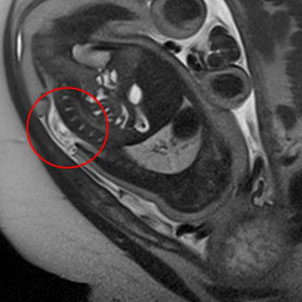Spina bifida
Spina bifida popularly known as "open back" is a malformation of the spinal cord already formed in the womb. Here, the closure of the bony spine and also depending on the extent the spinal cord and covering soft tissue is disturbed. Depending on the shape, there are various neurological deficits, e.g. paralysis and numbness of the legs or disorders of control of bladder and bowel.
Spina bifida occulta
In this type of malformation, the gap formation is closed in the bony spine, covered with intact skin. Typical findings, providing evidence for a spina bifida occulta are atypical patterns of hair growth or pigmentation of the skin above the malformation. If additional malformations of the spinal cord or its membranes exist (for example, Tethered Cord, Split Cord Malformation, Spinal lipoma or dermal), this may lead to neurological deficits and may require surgical treatment.

Depiction of a spina bifida with incomplete closure of the vertebral arches in the region of the sacral vertebral bodies as well as intraspinal lipoma and tethered cord (left sagittal and right axial T2-weighted)
Spina bifida aperta
In this type of malformation the defect is open and there is a protrusion of the spinal meninges (meningocele) or of the spinal cord with the meninges (myelomeningocele) outwards. The neurological deficits depend on the severity and amount of the defect. Often, a combination with other malformations such as the Chiari malformation is present. Because of the high risk of infection and the corresponding serious consequences a rapid operational treatment of this defect right after birth is the treatment of choice.

Depiction of a Spina bifida aperta with meningomyelocele in intrauterine MRI




